Lochhead on Marketing
149 Startup Downturn Marketing Mistake, What To Do About It, & Why People Who Create Demand Are In Massive Demand
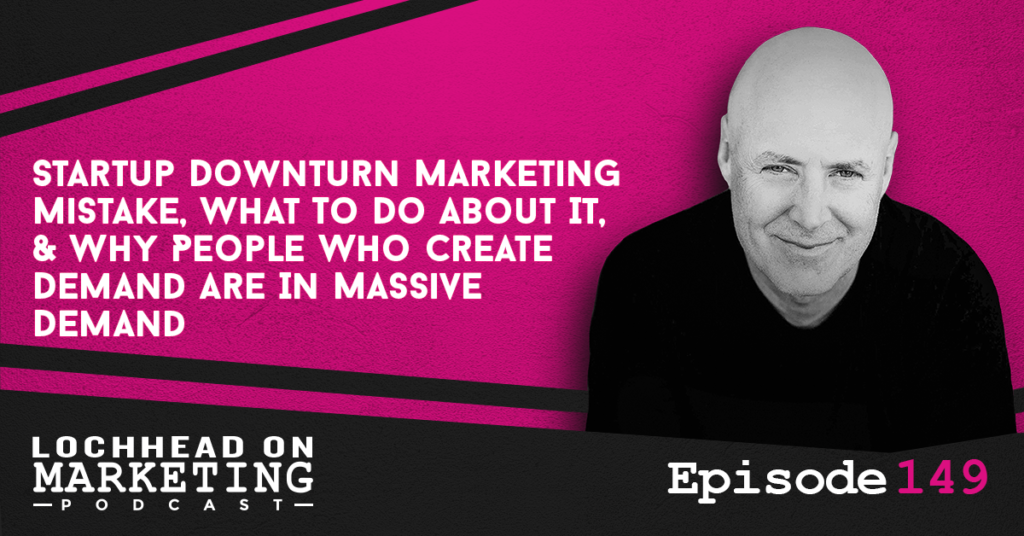
Podcast (lochheadonmarketing): Play in new window | Download (Duration: 18:37 — 12.8MB) | Embed
Subscribe: Apple Podcasts | Spotify | RSS | More
On this episode of Lochhead on Marketing, let’s talk about the big startup downturn marketing mistakes and what to do about it. We also talk about why people who create demand are in massive demand.
Lastly, there is the topic about your career, and what to do when the economy goes sideways, both in your business and in your career.
Welcome to Lochhead on Marketing. The number one charting marketing podcast for marketers, category designers, and entrepreneurs with a different mind.
Startup Downturn Marketing Mistake
The reality is, it’s not just startups who make this mistake.
But before that, let’s go through the top 10 list of what happens when the recession hits.
Number one, the recession hits. The immediate impact of that, of course, is number two, demand falls. So what do most companies do? Number three, they market hard in an effort to catch demand.
Remember, when most people say marketing, what they mean is compete in an existing market category for existing demand. So when they do marketing, what they’re really doing is demand capture.
So when the recession hits to demand falls, three, they market hard to catch, falling demand or some people say catch a falling knife. As a result, number four, customer acquisition costs aka CAC goes up.
Number six to nine is just running around in circles, repeating numbers two to four. Until you reach number ten, where they finally run out of time and money.
Here’s the big learning: He who competes for demand loses, she who creates demand wins. It also happens to be why category design is the most powerful underground skill in business. Most people don’t understand that just like you can create and design a product and accompany you could also create and design a market category.
Recession through a Different Lens
I get into trouble for saying this, but most people immediately assume a negative defensive position in a recession or a downturn. However, approximately 10% of companies get stronger during the recession.
In the last week, I have had many conversations with entrepreneurs and CEOs about how to take advantage of the coming downturn. I know that sounds crazy to a lot of people, but you can’t be in the 10%, that gets stronger, and you can’t be in the elite companies that actually are able to take advantage of a downturn unless you at least ask the questions. So I’m asking you to consider a different way.
Choosing a Different Way
So here’s the different way and specific as it relates to shrinking demand. So there’s three kinds of demand. Number one, as we talked about demand capture. Number two, demand creation. That’s why some people call it category creation.
One of the stupid arguments we hear all the time is, “well, category design is dumb, because why would we go to a market where there’s zero demand, and we have to create it all, when we can just catch demand? Okay? She who creates the demand wins. That’s why.
Now in a downturn, here’s the problem. It can take some time to create demand. People say, “well, we don’t have time our revenues falling, we need to generate revenue now.” This is where the third type of approach, wherein we dam the demand. By doing so, you redirect demand from an existing market to a new solution that your product or services provides.
To hear more about how to deal with Startup Downturn Marketing Mistake, download and listen to this episode.
Bio
Christopher Lochhead is a #1 Apple podcaster and #1 Amazon bestselling co-author of books: Niche Down and Play Bigger.
He has been an advisor to over 50 venture-backed startups; a former three-time Silicon Valley public company CMO and an entrepreneur.
Furthermore, he has been called “one of the best minds in marketing” by The Marketing Journal, a “Human Exclamation Point” by Fast Company, a “quasar” by NBA legend Bill Walton and “off-putting to some” by The Economist.
In addition, he served as a chief marketing officer of software juggernaut Mercury Interactive. Hewlett-Packard acquired the company in 2006, for $4.5 billion.
He also co-founded the marketing consulting firm LOCHHEAD; the founding CMO of Internet consulting firm Scient, and served as head of marketing at the CRM software firm Vantive.
We hope you enjoyed this episode of Lochhead on Marketing™! Christopher loves hearing from his listeners. Feel free to email him, connect on Facebook, Twitter, Instagram, and subscribe on iTunes!
148 Who Are You Going To Be When The Sh*t Hits The Fan
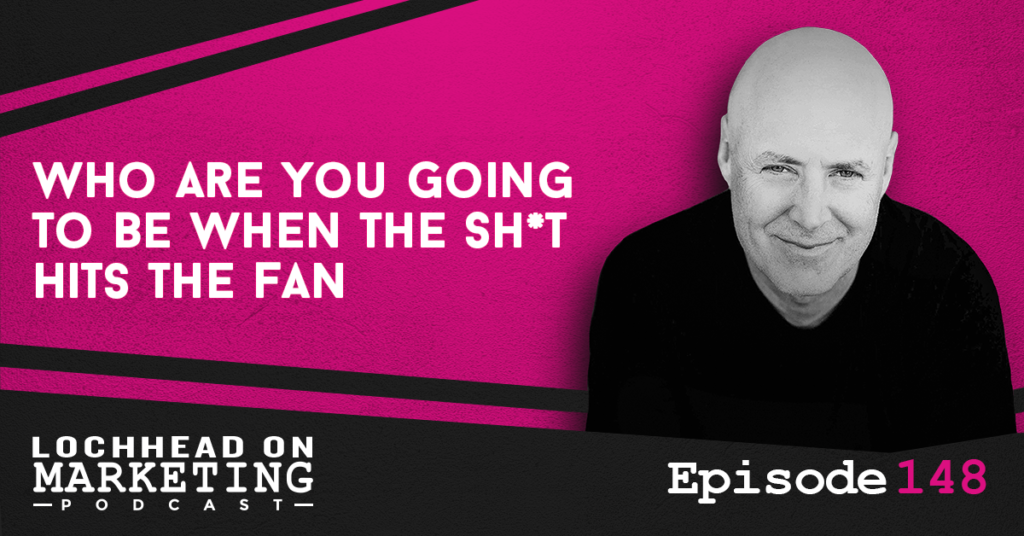
Podcast (lochheadonmarketing): Play in new window | Download (Duration: 35:17 — 24.2MB) | Embed
Subscribe: Apple Podcasts | Spotify | RSS | More
On this episode of Lochhead on Marketing, let’s talk about a critical question: Who are you going to be when the shit hits the fan?
As we have talked about in previous episodes, it is starting to look like the business environment could get very hard here. Some people in Silicon Valley are even saying that it could be like back in 2008. Sequoia Capital wrote their seminal “RIP, Good Times” presentation, and its final slide says, “Get real, or go home”. No matter what’s going to happen next in the economy, or frankly, the world, it’s probably time for all of us to get real or go home.
So let’s dig into why some people step up, and others melt down in times of crisis.
Welcome to Lochhead on Marketing. The number one charting marketing podcast for marketers, category designers, and entrepreneurs with a different mind.
The Signs
When I was in my late 20s, and into my early 30s, I was the founding CMO of a company called Scient. We were a leader in the we called E-business Innovation Space, we were one of the very first consulting firms to focus on building E-businesses or Digital Businesses. We did incredibly well, as a matter of fact, the company was founded, I believe, in 98, maybe late 97. By 2000, we had grown to almost 3000 people, which is incredible for a consulting startup, essentially. We were public and had a market cap of about $9 billion.
Now, if you were around back then, you’ve done your homework, and you know the.com bust happened. Like all bad things, they happen over time. It built starting by about February, March, we could feel things starting to get bad.
Shortly thereafter, we could feel the rumblings our pipeline wasn’t starting to look very good. There was weird shit happening with our customers. And there was a slow takedown that happened from about March, slowly, slowly, slowly, building over the summer, and by the fall, we were in a freefall.
Sh*t Hits the Fan
Due to all that, we had to do the first ever layoff in the history of the company. It was insanely painful.
So when we announced the miss in the projected stocks, we do the layoff. The people we laid off are amazing. They were cheering the company on saying please go forward and be successful sign had an incredible culture. So as painful as it was, the exiting people were, were incredible warriors and supporters. And the people who stayed really wanted to make a go of it.
However, people at management seemed to be focusing on the wrong things, rather than discussing how to move forward, given the resources we still had at the moment. This continued until I left the company, and from there the company continued on its freefall rather than picking itself up and starting anew.
How People React to Disruption
So why do I share that with you? It’s a great example of the shit hitting the fan for a company. In my opinion, an executive team unwilling to deal with the reality of the situation, and unwilling to deal with it with any kind of speed is a bad way to go at it. That’s why I got so mad and took off, and that’s why the CEO of the company fired me. After that, the company vaporized.
To hear more how legendary people react when disruption happens in the market, download and listen to this episode.
Bio
Christopher Lochhead is a #1 Apple podcaster and #1 Amazon bestselling co-author of books: Niche Down and Play Bigger.
He has been an advisor to over 50 venture-backed startups; a former three-time Silicon Valley public company CMO and an entrepreneur.
Furthermore, he has been called “one of the best minds in marketing” by The Marketing Journal, a “Human Exclamation Point” by Fast Company, a “quasar” by NBA legend Bill Walton and “off-putting to some” by The Economist.
In addition, he served as a chief marketing officer of software juggernaut Mercury Interactive. Hewlett-Packard acquired the company in 2006, for $4.5 billion.
He also co-founded the marketing consulting firm LOCHHEAD; the founding CMO of Internet consulting firm Scient, and served as head of marketing at the CRM software firm Vantive.
We hope you enjoyed this episode of Lochhead on Marketing™! Christopher loves hearing from his listeners. Feel free to email him, connect on Facebook, Twitter, Instagram, and subscribe on iTunes!
147 Why Most Tech Marketing Fails & What To Do About It with Chris Walker & Megan Bowen of Refine Labs
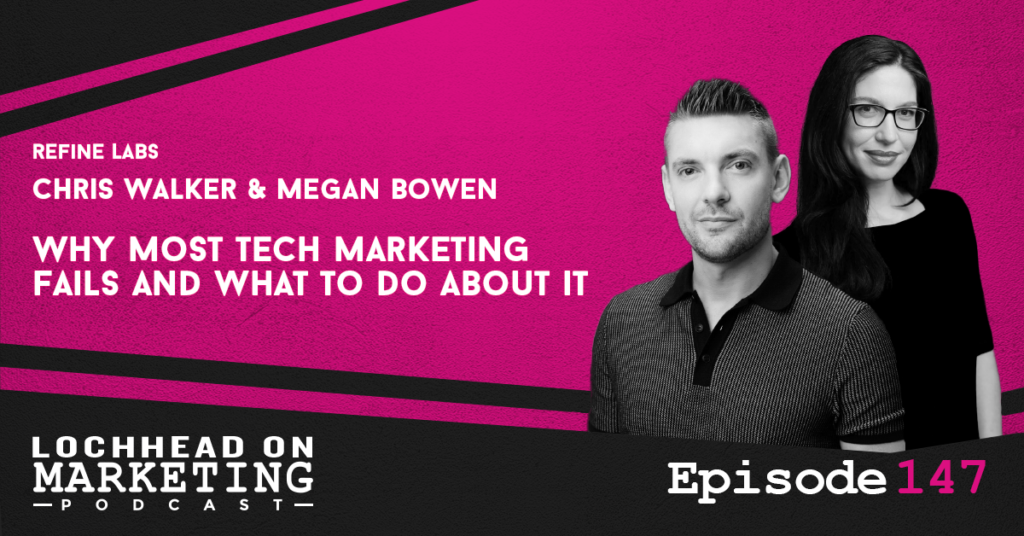
Podcast (lochheadonmarketing): Play in new window | Download (Duration: 1:18:39 — 54.0MB) | Embed
Subscribe: Apple Podcasts | Spotify | RSS | More
As you all know, normally there aren’t any guests for Lochhead on Marketing. But today, we have a special episode for tech entrepreneurs and marketers, as we have a dialogue with Megan Bowen and Chris Walker of Refine Labs.
Megan Bowen and Chris Walker are the COO and CEO of Refine Labs. They also have an amazing podcast, called The State of Demand Gen podcast.
As there have been a lot of bad thinking in marketing, a lot of which stems from old thinking. Chris and Megan have been doing a lot in helping drive the conversation onto new grounds, and making tech companies become in demand again. So if you’d like to hear their thoughts on the matter, stay tuned.
Welcome to Lochhead on Marketing. The number one charting marketing podcast for marketers, category designers, and entrepreneurs with a different mind.
Contributing to the Marketing World
The conversation starts with lauding Megan and Chris on the wonderful work they are doing on their podcast, State of Demand Gen. Christopher himself has been a guest before; you can check the episode here. But while Refine Labs has been around for a while, there’s not really a lot of things that people know about Chris and Megan, and what they do.
Megan shares that her background has always been in customer success and company operations. For her, Chris is the true visionary and disruptor when it comes to marketing.
“What I think I really bring to the table is a different way to think about company building. And I’ve had a ton of fun becoming a marketer in how we think about acquiring great talent and positioning our company in the eyes of candidates.” – Megan Bowen
Chris adds that without Megan, it would’ve been hard to make his ideas become reality.
A Clear Shift in the Market
Chris comments that it has been obvious to him and the team that there has been a shift in how people in B2B actually want to buy things. But surprisingly, a lot of companies are not adjusting to that reality because they’re stuck in the old ways of marketing.
“That shift sort of goes in line with what some of those topics that you talked about, Christopher. Native Digitals and Native Analogs is one piece of it. So how do people primarily want to engage research, discover, evaluate their suppliers and decisions and make decisions? How do they want to do that? As we start moving into the workforce, there’s more, I think you’ve mentioned, a stat of like, at least 50% of actual decision makers in a B2B buying process are now Native Digitals.” – Chris Walker
With this shift comes a lot of new opportunities and approaches to try out. So the slow adjustment of most companies nowadays to adapt to such things is what gives companies like Refine Labs to sort of “pop out of nowhere” and dominate the market.
On Native Digitals and Native Analogs
On the topic of Native Digitals and Native Analogs, it seems that S&P 500 CEOs, who are still majority Native Analogs, are not aware that the buying market is being overrun by Native Digitals. According to Chris, those who have noticed have started to create categories and marketing catering to that demographic. But for Chris, that isn’t nearly enough.
“I think that it’s important to look more holistically at the overall business. So some of the things that power our advantage. We think about our culture and our talent, talent, experience and talent management from a native digital lens. We think about building future products and experiences for customers through a native digital lens. And so when you look at the entire business, not just your marketing, there’s a lot of companies that can go out and put nice wallpaper on their marketing. Well, the foundations and stuff is cracking inside of the actual building.” – Chris Walker
Megan adds that it’s not only an approach that one should take in marketing, but in other aspects of the business as well.
“I think that a core component of any business, being successful and continuing to grow is attracting and retaining the right people to join their team and to continue to execute and innovate. And just like people are running old marketing plays and not catching up to what Native Digital’s need. Companies also have very antiquated ways that they think about retaining and attracting talent.” – Megan Bowen
To hear more from Megan Bowen and Chris Walker, and what you can do to avoid old marketing pitfalls, download and listen to this episode.
Bio
Megan Bowen
Megan Bowen has spent over a decade building and managing customer success and revenue generation teams for leading technology companies. She has worked with companies across the food, medical, and hospitality industries to create top-tier customer management functions, all focused on building long-term relationships and generating more revenue.
Megan currently leads marketing, sales, account management, client experience & operations teams at Managed by Q, the platform for office management. Her team is responsible for selling business-critical office services to new and existing clients, and providing workplace advice to thousands of companies with complex needs in the janitorial and maintenance spaces.
Prior to Q, Megan built the account management function for GrubHub/Seamless from scratch, and scaled the B2B client experience and account management structure for Seamless’ 5,000+ clients. Megan graduated from Adelphi University with a degree in Business Management.
Chris Walker
Chris Walker is the Founder and CEO of Refine Labs, a progressive demand generation firm that challenges the status quo in B2B marketing. Fueled by marketing execution at scale, Refine Labs uses real data from real customers to create demand strategy and research for their clients.
Before launching Refine Labs, Chris led marketing at two B2B firms where he built the foundation of his unique perspective on demand generation. Chris also hosts the State of Demand Gen podcast where he chats with today’s top B2B leaders to share tangible advice and tactics to over 15,000 marketers.
Chris Walker grew up in Boston, MA and graduated from Worcester Polytechnic Institute with a B.S. in Electrical & Computer Engineering and Biomedical Engineering. He started his professional career in the MedTech industry, migrating then into Product Management before making the move to marketing. Chris is also a serial entrepreneur, always finding ways to make an existing product or service better, or market a saturated product in different ways to break through the noise.
Links
Connect with Chris and Megan today!
Refine Labs | Chris’ LinkedIn | Megan’s LinkedIn | State of Demand Gen Podcast
We hope you enjoyed this episode of Lochhead on Marketing™! Christopher loves hearing from his listeners. Feel free to email him, connect on Facebook, Twitter, Instagram, and subscribe on iTunes!
146 13 Strategic Assumptions for Entrepreneurs, CEOs, CMOs and Executive Leaders
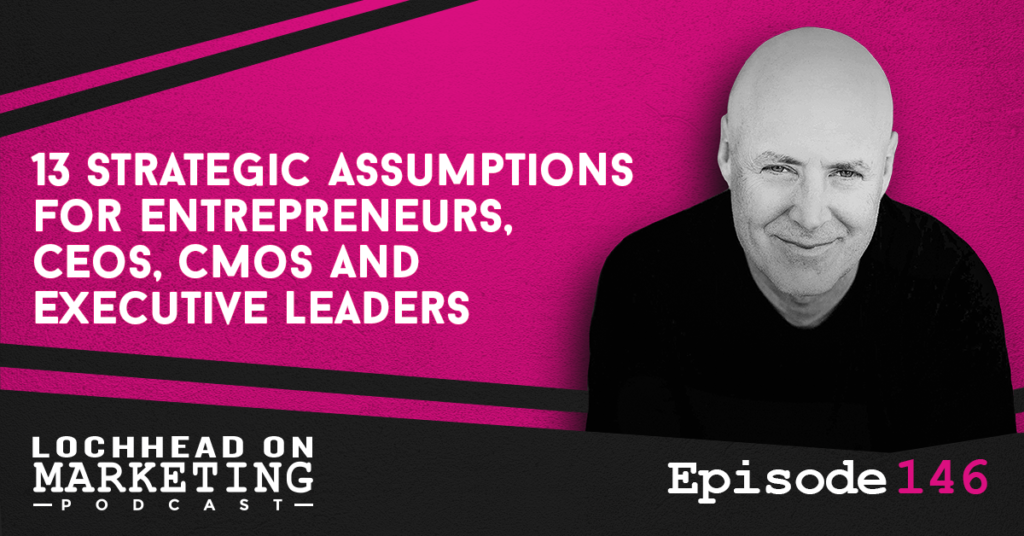
Podcast (lochheadonmarketing): Play in new window | Download (Duration: 14:06 — 9.7MB) | Embed
Subscribe: Apple Podcasts | Spotify | RSS | More
On this episode, let’s talk about some of the smart assumptions we can make about the rest of 2022.
Of course, this is based on the numerous dialogues I’ve had in the past months with some of the smartest entrepreneurs, VCs, CEOs, and executives in Silicon Valley. If you’re interested in those conversations, check out Christopher Lochhead: Follow Your Different in your podcast feed today.
Welcome to Lochhead on Marketing. The number one charting marketing podcast for marketers, category designers, and entrepreneurs with a different mind.
Assumptions for 2022
Without further ado, here are the assumptions that could happen during the rest of 2022:
- A Recession will happen – Most of the smart people in Silicon Valley and beyond are strategically planning for a recession, both in their business and in their personal lives. If it doesn’t happen, great. But it’s still better to have options should it be the case.
- Inflation will continue – The US government and the US Treasury trying to grapple with it right now. Wages are also going up, and supply lines are still challenged in many categories and industries.
- The Ukraine-Russia War will continue, and it will be long – David Gergen (FYD 266) said that he thought they would likely be sort of punch-drunk fighters before this thing ended. But we also had Dmitri Alperovitch (FYD 269), a renowned security expert, say that the war, or at least the major aspects of it, would be over within the month. Though there are still possibilities of digital skirmishes between the two. Regardless, the effects of this war will be far-reaching, and have humanitarian and economic impacts even after the war.
- David Sacks (FYD 267) says that there might be a GOP landslide in November – Right now, Biden’s approval ratings are some of the lowest in history, and Democrats don’t seem to have a way to rally themselves, or show a specific point of view or plan to hold their position.
- People are Hurting – People are on the edge. You can see it all over the place. People’s mental health seem a little fragile right now. These past couple of years have really taken its toll, and you can feel that fights could break out at the drop of a hat.
- It will take at least 5 years’ time before Native Analog CEOs, CMOs and C-level executives to understand that Native Digitals are the new category of human – A great example of this is you hear people talking about returning to work. We’re not returning to work, people might go back to physical offices, but we’re not returning to work native, Digital’s want to live in a native digital world. As long as Native Analogs executives do not recognize this, there will be a disconnect with the old and new categories, and those who fail to cope could be left behind.
- Variations and Market Caps will almost certainly continue to come down – That is what smart VCs are saying right now. So right now, they are “adjusting their thinking”. Given the data they have received over the past 12-24 months, they are expecting that there will be down runs that will happen.
- As a result of no. 7, raising money will be harder, and going public will also be harder – Most companies may very well have a tough time going public in the relative near term. But that should not discourage those who think that they have a new category opportunity to pursue them. It might just be the thing that helps you gather resources to go public.
- Cash is King again! (So manage it carefully) – This is also the result of both no. 7 and 8, so wise executive teams are managing their assets carefully.
- No one ever cost cut themselves to greatness – While it’s all well and good that you are able to manage your resources carefully, don’t be parsimonious.
- Recessions are not fun, but they can make good companies legendary – It is wise in tough economic times, to look for the growth opportunities to look for ways to make changes, and to look for ways to take your good company and make it legendary.
- Now is a great time to launch new categories – Given that now is a great time to launch new categories, if there are companies that are most companies are retrenching and look, the reality is most company leaders are like penguins. They follow whatever all the other penguins are doing. So if you want to create a new category, now is the best time to do so, while others are still retrenching or trying to “rebrand” their company.
- Now is a great time to do legendary work: tough times call for tough people – This is a tough time. It’s a scary time, the war is terrifying. The pain and suffering is horrible. The challenge in the economy is real and tough times call for tough people to stand up and do legendary work now is a great time to make the commitment to be that kind of legendary person.
Bio
Christopher Lochhead is a #1 Apple podcaster and #1 Amazon bestselling co-author of books: Niche Down and Play Bigger.
He has been an advisor to over 50 venture-backed startups; a former three-time Silicon Valley public company CMO and an entrepreneur.
Furthermore, he has been called “one of the best minds in marketing” by The Marketing Journal, a “Human Exclamation Point” by Fast Company, a “quasar” by NBA legend Bill Walton and “off-putting to some” by The Economist.
In addition, he served as a chief marketing officer of software juggernaut Mercury Interactive. Hewlett-Packard acquired the company in 2006, for $4.5 billion.
He also co-founded the marketing consulting firm LOCHHEAD; the founding CMO of Internet consulting firm Scient, and served as head of marketing at the CRM software firm Vantive.
We hope you enjoyed this episode of Lochhead on Marketing™! Christopher loves hearing from his listeners. Feel free to email him, connect on Facebook, Twitter, Instagram, and subscribe on iTunes!
145 All In Podcast “Rain Man” David Sacks of Craft Ventures on What Every Startup Leader Needs to Know Now
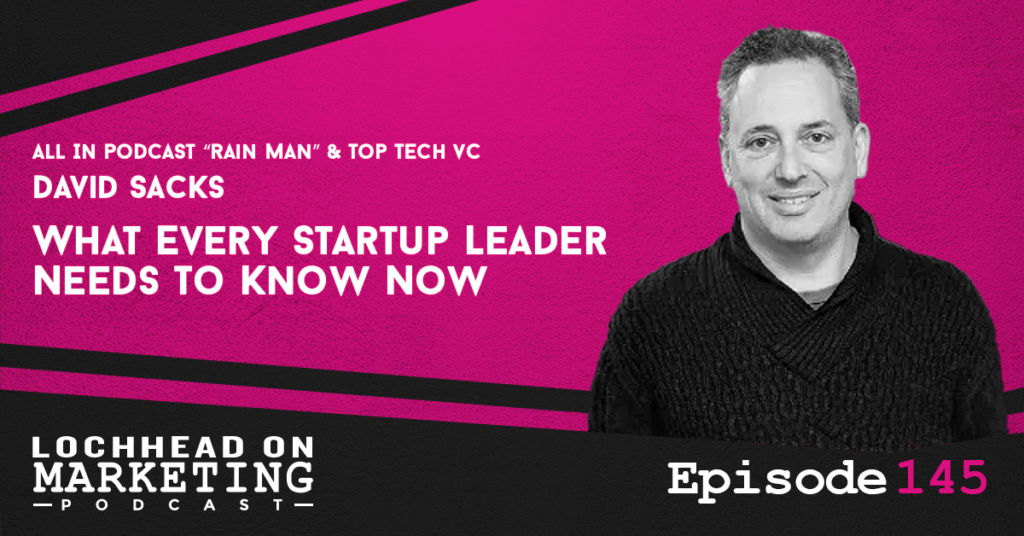
Podcast (lochheadonmarketing): Play in new window | Download (Duration: 20:47 — 14.3MB) | Embed
Subscribe: Apple Podcasts | Spotify | RSS | More
On this episode, we talk to David Sacks of Craft Ventures, on what every startup leader needs to know in the current business landscape.
If you didn’t know, I recently talked with David Sacks about a variety of topics, including business, current affairs, and how the two are interconnected. Even when we don’t always see it. If you want to check that out, go to Follow Your Different episode 267. This episode is a certain portion of that, which I thought bears highlighting here on Lochhead on Marketing. So listen up, and listen good.
Welcome to Lochhead on Marketing. The number one charting marketing podcast for marketers, category designers, and entrepreneurs with a different mind.
How 2022 will play out for VCs and Startups
The conversation starts on how 2021 was for venture capitalists and startups, which saw great growth on new businesses and new deals. Though the question that remains, according to David Sacks, is how sustainable it will be.
He notes that the huge growth was caused by certain situations in 2021, and how the public market reacted to it. But it seems that the market is slowly correcting itself, so we might expect to see a “slump” this year.
“Well, it’s gonna be very different than 2021, for sure. There’s a HUGE CORRECTION that’s been underway really since November, the public markets started correcting in November.” – David Sacks
Part of the huge growth was that there was an enormous liquidity injected into the markets as a result of the government reacting to COVID to act as a stimulus for the economy. The issue lies on the fact that they seem to have overdone it. To correct it, the market has seen inflation rise to new heights over the past months. It will seem erratic for now, but as the demand goes back and the excess stimulus wears off, we will see the market stabilize once more.
Consolidations and Mergers
One of the things that you often see during this time of sudden rise and slump in the market, is that a lot of acquisitions and mergers happen. It is because company’s valuation tends to drop during this time, so you could probably acquire one for far lower its original, especially compared to the high-rise last year.
One example is Salesforce, who acquired Slack on the height of the market boom last year. If they were to buy it at this current market, they might have gotten it for about 75% or less of what they originally paid for.
That goes for everybody. On paper, this should be the best time to acquire or merge with new assets. Yet that’s not what always happens because…
Prices are Sticky
On the other hand, it can be hard to get a lot of deals happening because they are still clinging onto the prices of the past.
“One of the reasons why there’s not a lot of deals happening right now is because in VC land is because prices are kind of sticky. I mean, all the founders remember the glory days, just six months ago, 100 times ARR. They’re still anchored on that. And they don’t believe that, like, there’s been this giant repricing, and that things could really be at 20 times ARR.” – David Sacks
They cling to this because most of them know that all they need is just one VC that is still willing to drink the Kool Aid and pay for 100 ARR, and they’re all set. So there’s going to be resistance to these changes and price levels.
To hear more from David Sacks and know what most startups need to know now, download and listen to this episode.
Bio
David Sacks is co-founder and general partner at Craft. He has been a successful founder and investor for over two decades, building and investing in some of the most iconic companies in tech. He has invested in over 20 unicorns, including Affirm, AirBnB, Bird, ClickUp, Eventbrite, Facebook, Houzz, Lyft, OpenDoor, Palantir, Postmates, Reddit, Slack, SpaceX, Twitter, Uber, and Wish.
David is also co-host of the popular “All-In Podcast” with Chamath Palihapitiya, David Friedberg, and Jason Calacanis.
David first got involved in the technology industry in 1999 when he joined early-stage startup Confinity, later renamed PayPal. Serving as the company’s first product leader and then as COO, David built and ran many of the company’s key teams, including product management and design, sales and marketing, business development, international, customer service, fraud operations, and HR. He pivoted the product from beaming money on Palm Pilots to emailing money on the web, and introduced the business model. When the company IPO’d on the Nasdaq in 2002, David was 29 — the median age of the “PayPal Mafia” executives listed on the S-1. PayPal was later acquired by eBay and eventually spun back out into a publicly traded company (under ticker symbol PYPL).
In 2008, David founded enterprise collaboration company Yammer, which was one of the first SaaS startups to apply consumer growth tactics to enterprise software. Yammer’s viral approach made it one of the fastest-growing SaaS startups in history, exceeding eight million enterprise users in just four years. As Founder/CEO of Yammer, David grew the company to roughly $60 million in sales and 500 employees. In July 2012, Microsoft acquired Yammer for $1.2 billion. It remains one of the fastest unicorn exits in SaaS.
Since Yammer, David has continued to be involved in the SaaS world, with an emphasis on “Bottom Up SaaS,” the strategy he pioneered at Yammer by combining product-led growth with B2B sales. Bottom-up SaaS companies combine the growth potential of B2C with the enterprise budgets of B2B, leading to explosive outcomes when ARR goes viral.
David is well known in Silicon Valley for his product acumen. AngelList’s Naval Ravikant has called David “the world’s best product strategist.” David likes to begin pitch meetings by seeing a product demo.
Links
Connect with David Sacks
Website | Bottom Up | All In Podcast | Twitter | LinkedIn
We hope you enjoyed this episode of Lochhead on Marketing™! Christopher loves hearing from his listeners. Feel free to email him, connect on Facebook, Twitter, Instagram, and subscribe on iTunes!
144 The First Native Analog vs Native Digital War: Volodymyr vs Vladimir (And What It Means For Every CEO & CMO)
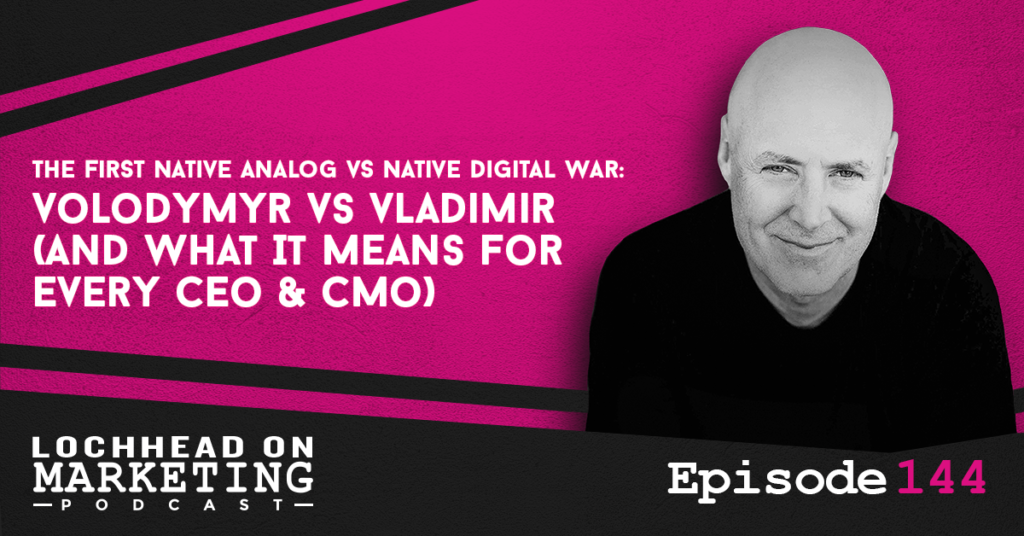
Podcast (lochheadonmarketing): Play in new window | Download (Duration: 15:15 — 10.5MB) | Embed
Subscribe: Apple Podcasts | Spotify | RSS | More
Welcome to a very special episode of Lochhead on Marketing. This episode is based on a recent Category Pirates newsletter that we wrote, which is about Ukraine, the Native Analog and Native Digital war, and what it means for every business person.
If you haven’t subscribed to Category Pirates?☠️ yet, click the link and check it out. You’ll find a few goodies and mini-books waiting for you there.
That said, think of this episode as more of an audiobook than a podcast, as I will be reading the article for you. Without further ado, let’s get to reading.
Part I
Over the past year, we have written extensively about the bifurcation between Native Analogs & Native Digitals.
- Native Analogs are Baby Boomers and Gen Xers born anywhere from the 1940s all the way up to the early ‘80s. Today, they range between the ages of 40 to 75, and make up approximately 136.8 million Americans.
- Native Digitals are Millennials, Gen Zers, and beyond, born between the early 1980s to as recently as the 2010s. These demographics are around 35 years of age on the high end, down to as young as 6 years old, and make up approximately 140.1 million Americans.
Much has been written in the past 20 years about “Digital Natives,” but this is a loose understanding of the chasm between these two demographics. When we say “Native Analogs” and “Native Digitals,” we are not talking about age.
We are talking about identity.
“Native Digital” is not a mindset. It does not mean “some people embrace technology while others do not.” It also doesn’t mean if you’re old, you’ll never “get it.” We created the terms Native Analog and Native Digital to introduce shared language that would allow society to discuss the differences between people whose primary life experience is Analog-first (in the real world) from people whose primary life experience is Digital-first (online).
Again, this is not an Old vs Young issue.
This is a first-time-ever-in-human-history phenomenon: Native Analogs are the last of a dying breed, and Native Digitals are a new category of human.
And from here on out, there will never be another Native Analog generation born ever again.
Think about that.
Part II
Native Digitals grew up integrated with the digital world.
They had smartphones before they had college degrees, high school diplomas, or (for Gen Zers) a bicycle to ride around the neighborhood. (“Bicycle? Why? All my friends are online.”) They grew up integrated with the cloud. They don’t know what it’s like to not have the answer to any and every question in their pocket, two taps and a swipe away. The digital world is where they primarily live.
(And when parents restrict their screen time, whether they realize it or not, they are removing them from their primary lives and threatening their core life experience.)
The Native Analog & Native Digital lens is fascinating in and of itself, but it gets more powerful when changes in the world are viewed and understood through it.
For example: nowhere in the media have we seen anyone discuss the Russia/Ukraine war through the Native Analog & Native Digital lens.
Most people think this support for Ukraine “just happened” (the same way most business media think demand for a given business just “happens,” like the weather). It did not. The support was created—in exactly the same way Category Designers create net-new demand out of thin air.
Volodymyr’s digital dominance has led to historic pressure being put on governments and corporations to inflict more economic pain on Russia than has ever been levied on any country, ever. It used to be that what happened in the analog world dictated what happened in the digital world—but now, the two have flipped (and most people don’t see this radical transformation happening in plain sight). Digital stories, digital messages, digital photos, digital conversations, and the subsequent digital movement in support for Ukraine that has had catastrophic consequences for Russia in the analog world.
Part III
Goldman Sachs CEO, David Solomon (Native Analog), recently mandated that his employees return to the office.
Until Native Analog leaders understand that Native Digitals are a new category of human, with a 180-degree difference in the way they experience life and world, they will not understand one of the biggest changes in the development of our species.
And their ability to successfully lead will diminish at ever-accelerating rates.
- Vladimir Putin is fighting an analog-only war.
- Volodymyr Zelenskyy is fighting an analog AND digital war.
(That’s a big part of why Volodymyr is winning.)
And this is exactly what’s happening in the business world today.
To hear the whole Category Pirates newsletter article, download and listen to this episode. Better yet, subscribe to Category Pirates?☠️ today and learn more about Native Digitals and how they are taking over the world without us knowing.
Bio
Christopher Lochhead is a #1 Apple podcaster and #1 Amazon bestselling co-author of books: Niche Down and Play Bigger.
He has been an advisor to over 50 venture-backed startups; a former three-time Silicon Valley public company CMO and an entrepreneur.
Furthermore, he has been called “one of the best minds in marketing” by The Marketing Journal, a “Human Exclamation Point” by Fast Company, a “quasar” by NBA legend Bill Walton and “off-putting to some” by The Economist.
In addition, he served as a chief marketing officer of software juggernaut Mercury Interactive. Hewlett-Packard acquired the company in 2006, for $4.5 billion.
He also co-founded the marketing consulting firm LOCHHEAD; the founding CMO of Internet consulting firm Scient, and served as head of marketing at the CRM software firm Vantive.
We hope you enjoyed this episode of Lochhead on Marketing™! Christopher loves hearing from his listeners. Feel free to email him, connect on Facebook, Twitter, Instagram, and subscribe on iTunes!
143 What’s the Role of Business, Beyond Business?
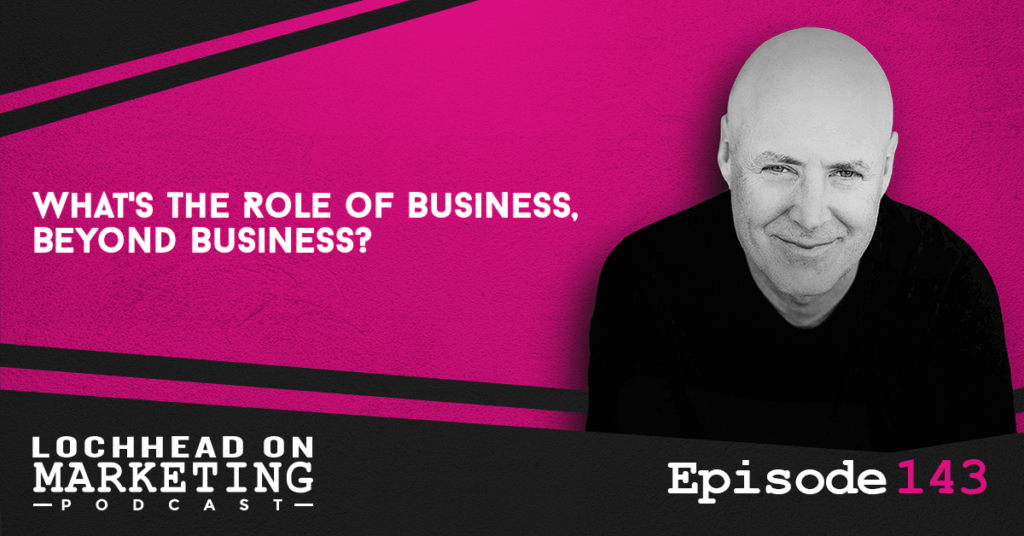
Podcast (lochheadonmarketing): Play in new window | Download (Duration: 7:13 — 5.0MB) | Embed
Subscribe: Apple Podcasts | Spotify | RSS | More
On this episode of Lochhead on Marketing, let’s ask what is the role of business, beyond just business.
Today marks the 5th day into the Russian invasion of the Ukraine, the first attack of its kind since Sept. 1, 1939 – the start of World War 2. So let’s talk about how this affects businesses, and how businesses can affect it.
Roll Call for Companies
According to the Wall Street Journal, the US is still buying 8% of its oil from Russia. On the commercial side, there has been no announcements by companies such as McDonalds, KFC, Burger King, and Papa John’s to name a few, on closure of their branches in Russia, temporary or otherwise.
On the tech side of things, there have also been no word from Jeff Bezos, Bill Gates, Mark Zuckerberg, nor from Google CEO Sundar Pichai, Microsoft CEO Satya Nadella, as well as CISCO CEO Chuck Robbins and Oracle CEO Safra Catz on their stance and plans as things progress in Russia.
I’m disheartened, somewhat defeated, and absolutely fucking royally mad about the silence from Silicon Valley on this topic.
There are some exceptions, of course. Criticize the man all you like, but Elon Musk made a commitment to keep the Ukraine connected to the internet via his Starlink satellite internet. Less than 48 hours after he made that promise, a shipment of Starlink terminals arrived in the Ukraine.
Businesses Getting Involved in War
There are those on the web that criticize people who celebrate when big corporations do something in the situation. My response to them is this:
“Anyone who supports in any way, a free democratic society, who is being invaded, attacked, and mass murdered is a hero.” – Christopher Lochhead
Now, if you wish to join me in making a financial contribution, we took a list of charities helping in the Ukraine(published by NBC News). You can check out that list of charities and I encourage you to crack open your wallet and see if you can make a difference for the people of Ukraine. You can also donate to Doctors Without Borders as they mobilize to help Ukraine and nearby countries that were affected.
The Role of Businesses beyond Business
As a business owner or entrepreneur, you might be asking – how exactly can businesses help in this situation?
Well, imagine what would happen if all the tech security companies pulled the plug on the Russian government and on major Russian enterprise. Imagine if all tech infrastructure companies pulled the plug on Russia. Imagine if all of the SAS application companies, the database companies, the gaming companies, the IT operations companies shut down Russia’s digital world, the digital world is as important today as the analog world. if they manage to shut down the Russians government’s ability to do things in the digital world, we’re going to shut down a lot.
Of course, there are certain companies and certain situations where it makes sense to keep doing business. In Russia, for example, communication, and social platforms is critical for Russian citizens to be able to see and hear what their government is doing in the Ukraine.
So what leaders do in times of crisis matters, what you and I do in times of crisis matters. If the US federal government will not stop buying Russian blood oil, will we stop doing business with Russia? Will our CEOs put peace before profits? Or will businesses do whatever they want to do?
It’s easy to be great when everything’s great. But what defines our lives is who we choose to be in times of crisis.
Bio
We hope you enjoyed this episode of Lochhead on Marketing™! Christopher loves hearing from his listeners. Feel free to email him, connect on Facebook, Twitter, Instagram and subscribe on iTunes!
142 Marketing’s Job Is NOT Serving Internal Customers
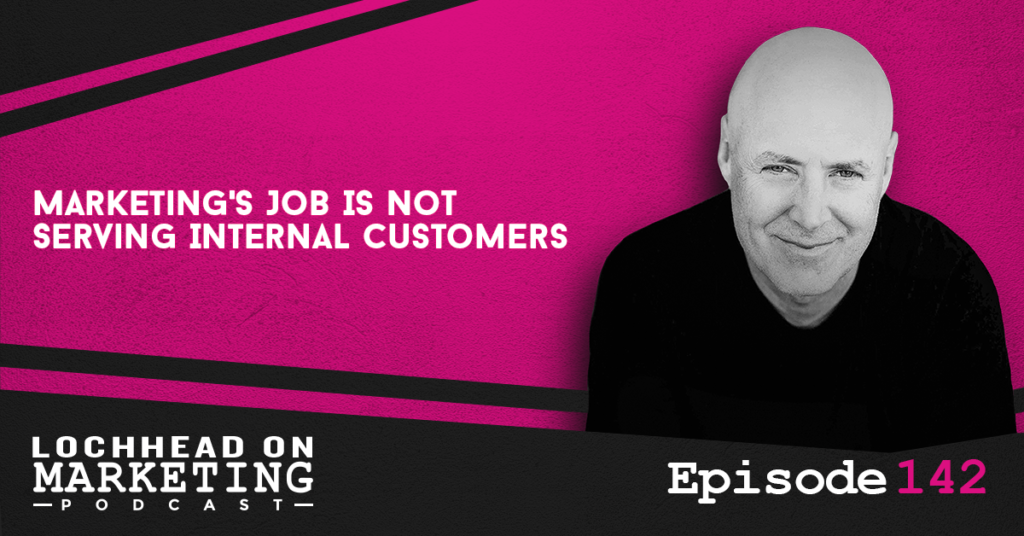
Podcast (lochheadonmarketing): Play in new window | Download (Duration: 13:45 — 9.4MB) | Embed
Subscribe: Apple Podcasts | Spotify | RSS | More
On this episode, let’s talk about one of the things that drives me the craziest and more importantly, ruins marketing results and careers on a regular basis. That is, why marketing’s job is NOT serving internal customers.
Speaking of which, I want to thank you from the bottom of my heart for making our new books into bestsellers at Amazon Books. You can check the whole list Category Pirates mini-books at Amazon Books, and expect more in the near future!
Welcome to Lochhead on Marketing. The number one charting marketing podcast for marketers, category designers, and entrepreneurs with a different mind.
The Concept of Internal Customers is Dumb
The idea of an Internal Customer is dumb. Listen to it: Internal Customer. First of all, what does a customer do that an internal department or “internal customer” doesn’t? That’s right, customers actually pay you money.
Companies who are so internally focused and direct marketing inwardly, that they are confused as to what it should be targeting is a company destined for disaster.
So point number one is this:
“There is only one customer, and those are your actual customers.” – Christopher Lochhead
You can put whatever modifier in front of customer you want, but customers or consumers and putting a stupid modifier in front of them is well, frankly stupid.
What Marketing should be doing
That said, what really is marketing?
Firstly, Marketing is a leadership function. Its job is to lead the company, lead the category and ultimately design and dominate a legendary category that matters around solving problems or creating opportunities for customers.
Second, marketing organizations often get trapped in this feeling of being an internal service bureau. That’s ridiculous. Marketing is no is no more of a internal service function than finance than engineering or products. d in this being of being an internal service bureau. HR is not a service function either. It’s a leadership function.
So the first thing to understand is marketing is a leadership function, whose job is to partner with the rest of the organization in creating, designing, and dominating a market category that makes a giant difference for customers who pay us money.
How Marketing works within the Organization
Now, what does that mean for how marketing works within the organization? You do it as leaders, as you partner with other leaders.
So is Sales Enablement important? Yes, of course it’s important. As a marketing leader, we want the sales organization to love us. Are there a certain set of things that we want to deliver to sales to help them be successful in their job? Of course, there are. But we’re not order takers, we’re leaders. And we’re partners. We’re in a co creation relationship.
You’re in the business of co-creating a legendary relationship. Are there some service elements of that? Sure, there are. But that is not the primary paradigm, the primary paradigm is a co-creation relationship.
That’s the relationship marketing wants to have with sales, that is to say, both of which should get together and say, what are our objectives for the year for the quarter for the month? How do we partner together to produce legendary revenue with the exact kind of customers that we want? So in that regard, marketing and sales work together, hand in glove.
To hear more on how Marketing should be done in your business, download and listen to this episode.
Bio
Christopher Lochhead is a #1 Apple podcaster and #1 Amazon bestselling co-author of books: Niche Down and Play Bigger.
He has been an advisor to over 50 venture-backed startups; a former three-time Silicon Valley public company CMO and an entrepreneur.
Furthermore, he has been called “one of the best minds in marketing” by The Marketing Journal, a “Human Exclamation Point” by Fast Company, a “quasar” by NBA legend Bill Walton and “off-putting to some” by The Economist.
In addition, he served as a chief marketing officer of software juggernaut Mercury Interactive. Hewlett-Packard acquired the company in 2006, for $4.5 billion.
He also co-founded the marketing consulting firm LOCHHEAD; the founding CMO of Internet consulting firm Scient, and served as head of marketing at the CRM software firm Vantive.
We hope you enjoyed this episode of Lochhead on Marketing™! Christopher loves hearing from his listeners. Feel free to email him, connect on Facebook, Twitter, Instagram, and subscribe on iTunes!
141 Why Most Marketing Fails, and what CEOs and CMOs need to know to fix it
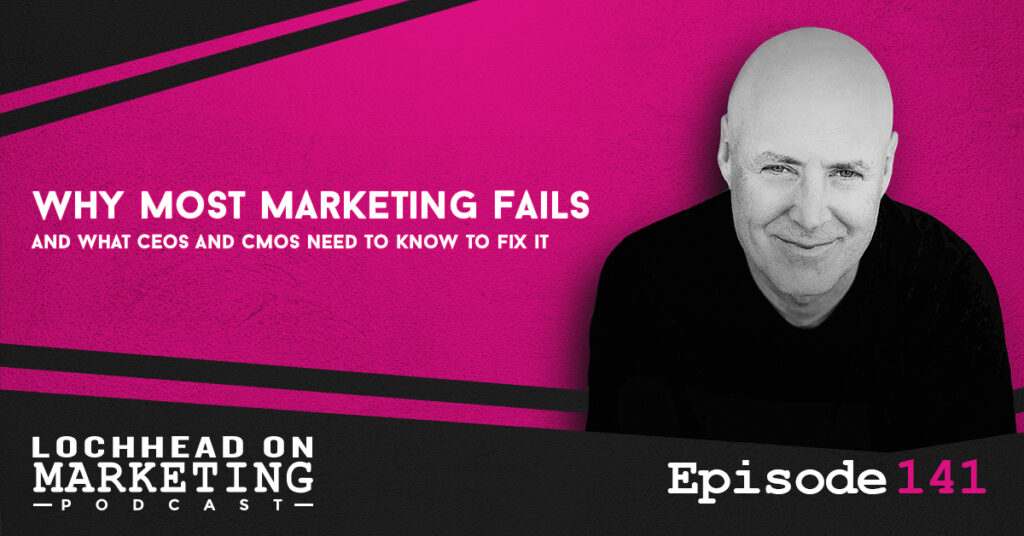
Podcast (lochheadonmarketing): Play in new window | Download (Duration: 8:30 — 5.8MB) | Embed
Subscribe: Apple Podcasts | Spotify | RSS | More
On this episode, let’s talk about why most marketing fails, and what we can do about it.
Speaking of marketing, I want to thank you from the bottom of my heart for making our new books into bestsellers at Amazon Books. You can check the whole list Category Pirates mini-books at Amazon Books, and expect more in the near future!
Welcome to Lochhead on Marketing. The number one charting marketing podcast for marketers, category designers, and entrepreneurs with a different mind.
The Marketing Folklore
When most people say marketing, they usually have a preconceived notion to what it is. That is, to compete for an existing demand with a better product and a better brand in an existing market category.
The reason most people think like this is that it is what is taught in business schools and MBAs. That’s what is said a lot in marketing books and the like. So it has become a belief, almost a folklore, that things should be done as such.
Competing for Leftovers
The problem with this line of thinking is that it’s a very bad idea.
We did a data science project published in the HBr, as well as in our newsletter Category Pirates, and discovered something fascinating. We found that in tech categories, on average, the category king or queen wins 76% of the total value created, as measured by market cap in the entire category.
This means, if you’re not doing category design, you’re playing in someone else’s category. When somebody says marketing, what they’re really saying is, we are going to fight for the remaining 24% of the value.
The issue now is that most companies don’t realize that they’re only fighting for a small piece of the pie.
“Because the vast majority of marketers don’t know that that’s what they’re doing. When they hear the word marketing, they make an unconscious, undiscussed unanalyzed choice to compete in a category designed by somebody else, which only allows for 24% of the value.
And that is why most marketing fails.” – Christopher Lochhead
Bio
Christopher Lochhead is a #1 Apple podcaster and #1 Amazon bestselling co-author of books: Niche Down and Play Bigger.
He has been an advisor to over 50 venture-backed startups; a former three-time Silicon Valley public company CMO and an entrepreneur.
Furthermore, he has been called “one of the best minds in marketing” by The Marketing Journal, a “Human Exclamation Point” by Fast Company, a “quasar” by NBA legend Bill Walton and “off-putting to some” by The Economist.
In addition, he served as a chief marketing officer of software juggernaut Mercury Interactive. Hewlett-Packard acquired the company in 2006, for $4.5 billion.
He also co-founded the marketing consulting firm LOCHHEAD; the founding CMO of Internet consulting firm Scient, and served as head of marketing at the CRM software firm Vantive.
We hope you enjoyed this episode of Lochhead on Marketing™! Christopher loves hearing from his listeners. Feel free to email him, connect on Facebook, Twitter, Instagram, and subscribe on iTunes!

